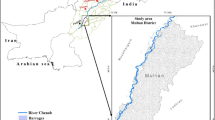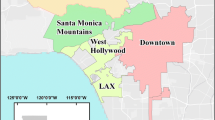Abstract
Sub-Saharan African countries are being strongly urged to enhance their rice production, because their rice consumption and importation rates have been rapidly increasing in recent years. Areas planted to rice in Africa are classified agro-ecologically into rainfed upland, rainfed lowland, and irrigated. Rainfed lowland includes extensive areas of unexploited land that has great potential for the promotion of rice growing. For the unexploited rainfed lowlands of Ghana, we have been studying the development of low-cost rice-farming systems that require no large-scale irrigation or land reclamation. For such systems, it is important to select suitable areas where water for rice farming can be obtained naturally; floodwaters offer promise for this purpose. Delineation and mapping of floodwater prone areas suitable for rice production is important for successful utilization of this land resource. Here, we propose a method of assessing flood probability from submergence frequency, as estimated from satellite imagery and geospatial data. ALOS/PALSAR images acquired in May, June, August, and September 2010 were used to classify land and water, and then a submerged-area map was produced. From the results, we were able to accurately detect non-submerged areas and submerged areas with water depths of at least 3 cm. The number of times classified into submerged area was defined as submergence frequency, and it was approximated by distance from reservoirs representing White Volta River, ponds, and swamps. In addition, flood extent derived from reservoirs was simulated using digital elevation model (DEM). Finally, a flood probability assessment map was produced by integration of the estimated submergence frequency and flood extent simulation. The results of a comparison of soil moisture data measured at 69 points in the field and the NDVIs computed by ALOS/AVNIR showed that areas with high potential for flooding retained high levels of soil moisture and were more likely to show less deterioration of vegetation in the dry season. The validation of these results confirmed the adequacy of the flood probability assessment method.












Similar content being viewed by others
References
Buheaosier, Kaneko, M., Takada, M., & Tsuchiya, K. (2002). The classification of vegetation of wetland based on remote sensing methods, over Kushiro Wetland Hokkaido Japan. Report of Institute of Environmental Sciences, Hokkaido Research Organization, 29, 53–58. http://www.hokkaido-ies.go.jp/center/Book/Report/H14/29-53-all.pdf. Accessed 17 November 2011.
Dahdouh-Guebas, F. (2002). The use of remote sensing and GIS in the sustainable management of tropical coastal ecosystems. Environment, Development and Sustainability, 4(2), 93–112.
Earth Observation Research Center/Japan Aerospace Exploration Agency (EORC/JAXA). (2007). ALOS User Handbook. http://www.eorc.jaxa.jp/ALOS/en/doc/alos_userhb_en.pdf. Accessed May 17, 2012.
Earth Observation Research Center/Japan Aerospace Exploration Agency (EORC/JAXA). (2008).ALOS data users handbook revision C, 3–14—3–17. http://www.eorc.jaxa.jp/ALOS/en/doc/fdata/ALOS_HB_RevC_EN.pdf. Accessed May 17, 2012.
Gifu Prefecture. (2001). Guideline of paddy rice cultivation in Gifu Prefecture (Japanese) (pp. 18–19). http://www.maff.go.jp/j/seisan/kankyo/hozen_type/h_sehi_kizyun/pdf/suito2.pdf. Accessed May 10, 2012.
Guo, H. D. (2000). Spaceborne and airborne SAR for target detection and flood monitoring. Photogrammetric Engineering and Remote Sensing, 66(5), 611–617.
Haruyama, S., & Shida, K. (2006). Food risk evaluation of the Mekong river delta utilizing JERS-1 SAR images. Journal of Geography, 115(1), 72–86. (in Japanese with English abstract) http://www.pfwrmankamoto.com/pfwrfiles/Haruyama%20SAR%20Mekong%20delta%20flood%20risk%20analysys.pdf. Accessed Nov 17, 2011.
Hoekman, D. (2009). 13. Monitoring tropical peat swamp deforestation and hydrological dynamics by ASAR and PALSAR. In P.-G. Peter Ho (Ed.), Geoscience and remote sensing (pp. 257–275). InTech, ISBN 978-953-307-003-2. http://www.intechopen.com/books/show/title/geoscience-and-remote-sensing. Accessed Nov 17, 2011.
Hokkaido Regional Development Bureau, Ministry of Land, Infrastructure, Transport and Tourism. (2009). Manual for practical usage of Remote Sensing for Hokkaido agriculture (Revised). (in Japanese) http://www.hkd.mlit.go.jp/zigyoka/z_nogyo/remote/. Accessed Nov 17, 2011.
Ishitsuka, N. (2006). Using Synthetic Aperture Radar (SAR) to measure the area of rice cultivation. Bulletin of National Institute for Agro-Environmental Sciences, 24, 95–151. (written by Japanese with English abstract).
Ishitsuka, N. (2007). The scatter characteristic of rice paddy fields using L band multi polarimetric satellite SAR observation. Proceedings of The First Joint PI Symposium of ALOS Data Nodes for ALOS Science Program in Kyoto. http://www.eorc.jaxa.jp/ALOS/conf/Proc_PIsymp2007/contents/proceedings/Agriculture/AGR05.pdf. Accessed May 17, 2012.
Japan International Cooperation Agency (JICA) & Alliance for a Green Revolution in Africa (AGRA). (2008). Coalition for African Rice Development. http://www.jica.go.jp/english/operations/thematic_issues/agricultural/pdf/card_02_en.pdf. Accessed Nov 17, 2011.
Kagawa Prefecture. (2012). Water-saving culture technology for paddy rice (Japanese). http://www.pref.kagawa.jp/agrinet/dougubako/saigai/pdf/kangai_yousuibusoku/suitou_saibaikijun.pdf. Accessed May 10, 2012.
Kato K., & Yamazaki, F. (2010). Detection of flooded areas using ALOS/PALSAR images for the 2008 Iwate-Miyagi inland earthquake. Journal of Japan Association for Earthquake Engineering (written by Japanese with English abstract). http://www.jaee.gr.jp/stack/submit-j/v10n03/hon/100301_Paper.pdf. Accessed Nov 17, 2011.
Kim, J. W., Lu, Z., Lee, H., Shum, C. K., Swarzenski, C. M., Doyle, T. W., et al. (2009). Integrated analysis of PALSAR/Radarsat-1 InSAR and ENVISAT altimeter data for mapping of absolute water level changes in Louisiana wetlands. Remote Sensing of Environment, 113, 2356–2365.
Leeuw, M. R., & Carvalho, L. M. T. (2009). Performance evaluation of several adaptive speckle filters for SAR imaging. Anais XIV Simpósio Brasileiro de Sensoriamento Remoto, 7299-7305. Natal, Brasil, 25–30 abril 2009, INPE.
Martinez, J. M., & Toan, T. L. (2007). Mapping of flood dynamics and spatial distribution of vegetation in the Amazon floodplain using multitemporal SAR data. Remote Sensing of Environment, 108, 209–223.
Matsuoka, M., Horie, K., & Ohkura, H. (2007). Application of satellite SAR based damage detection technique to the 2004 Niigata-ken Chuetsu earthquake and its upgrade. Journal of Structural and Construction Engineering, 617, 193–200 (written by Japanese with English abstract).
Milne, A. K., & Tapley, I. J. (2010). Wetland monitoring of flood-extent, inundation patterns and vegetation, Mekong River Basin, Southeast Asia, and Murray-Darling Basin, Australia. In The ALOS Kyoto Carbon initiative science team reports phase 1 (2006–2008) (pp. 148–156). Tokyo: JAXA. http://www.eorc.jaxa.jp/ALOS/kyoto/ref/KC_Phase-1_ScienceTeamReports_JAXA-EORC_NDX-100003.pdf. Accessed Nov 17, 2011.
Ministry of Food and Agriculture, The Republic of Ghana. (2009). National Rice Development Strategy (NRDS). http://www.riceforafrica.org/downloads/NRDS/ghana_en.pdf. Accessed Aug 11, 2011.
National Agricultural Research Center for Tohoku Region, Commonly-used water management for paddy according to growing stage (Japanese). http://www.reigai.affrc.go.jp/zusetu/kangai.html. Accessed May 10, 2012.
Niigata Prefecture. (2005). Guideline of paddy rice cultivation (Japanese) (p. 50). http://www.maff.go.jp/j/seisan/kankyo/hozen_type/h_sehi_kizyun/pdf/04180109hondenkanri.pdf. Accessed May 10, 2012.
Ochi, S. & Shibasaki, R. (1999). Algorithm for Generating Drainage Direction Matrix using DEM (GTOPO3O) and DCW. Journal of the Japan Society of Photogrammetry and Remote Sensing, 38(3), 60–68 (in Japanese with English abstract). http://www.journalarchive.jst.go.jp/jnlpdf.php?cdjournal=jsprs1975&cdvol=38&noissue=3&startpage=60&lang=ja&from=jnltoc. Accessed Nov 17, 2011.
Takeuchi, W. & Yasuoka, Y. (2004). Development of normalized vegetation, soil and water indices derived from satellite remote sensing data. Journal of the Japan Society of Photogrammetry and Remote Sensing, 43(6), 7–19 (in Japanese with English abstract). http://www.journalarchive.jst.go.jp/jnlpdf.php?cdjournal=jsprs1975&cdvol=43&noissue=6&startpage=7&lang=ja&from=jnltoc. Accessed Nov 17, 2011.
Tochigi Prefecture. (2010). Guideline of paddy rice cultivation (Japanese). http://www.pref.tochigi.lg.jp/g05/work/nougyou/seisan-ryuutsuu/documents/1275980505447.pdf. Accessed May 10, 2012.
Toyama Prefecture. (2010). Newsletter on direct seeding of paddy rice (Japanese). http://www.pref.toyama.jp/branches/1632/noringyo/himi/2305himijika02.pdf. Accessed May 10, 2012.
Tuan T. A., & Duong, N. D. (2009). Flood monitoring using alos/palsar imagery. 7th FIG Regional Conference Spatial Data Serving People: Land Governance and the Environment—Building the Capacity. Hanoi, Vietnam, 19–22 October 2009. http://www.fig.net/pub/vietnam/papers/ts03e/ts03e_tuan_duong_3720.pdf. Accessed Nov 17, 2011.
Wakatsuki, T. (2007). Towards the realization of a green revolution through paddy rice development in West Africa: From experiences in Nube in Nigeria and Ashanti in Ghana. Faculty of Agriculture, Kinki University (in Japanese). http://www.kinki-ecotech.jp/Afuricano-ningennkaihatu173-219.pdf. Accessed Nov 17, 2011.
Yonezawa, C., Saito, G., Hori, M., & Watanabe, M. (2010). Continuous monitoring of landslides area caused by Iwate-Miyagi nairiku earthquake in 2008 using ALOS images. International Archives of the Photogrammetry, Remote Sensing and Spatial Information Science, XXXVIII(8), 44–47.
Acknowledgments
This study has been implemented as a part of the international research project entitled “Development of rice production technologies in Africa” conducted by Japan International Research Center for Agricultural Sciences, Japan. The authors would like to extend their thanks to Dr. Stephen K. Nutsuga, Director, SARI for his meticulous consultation, and Mr. Yahaya Inusah and Mr. Alhassan Zakaria who are principal technical officers in SARI for their dedicated assistance.
Author information
Authors and Affiliations
Corresponding author
Rights and permissions
About this article
Cite this article
Yamamoto, Y., Tsujimoto, Y., Fujihara, Y. et al. Assessing the probability of land submergence for lowland rice cultivation in Africa using satellite imagery and geospatial data. Environ Dev Sustain 14, 955–971 (2012). https://doi.org/10.1007/s10668-012-9363-7
Received:
Accepted:
Published:
Issue Date:
DOI: https://doi.org/10.1007/s10668-012-9363-7




